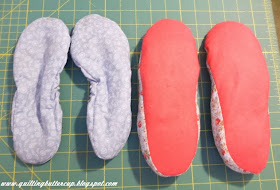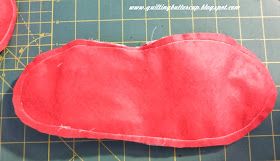These cute ballerinas can be made of all kinds of fabrics. Use cotton fabric and thin batting for summer as I did for the shoe in the picture above. In winter, use thicker fabrics and batting and add an insole. The ballerina in the picture below has an upper outer shell of cotton fabric while the inside is made of warm fleece. The sole is made of an insole, thick polyester batting and pink felt.
You will need a template for the size of your feet. I am preparing the template for european sizes 36-41, it should be available for download from craftsy in the coming days. You will need to mirror the pieces for the sole while the top is the same for both feet. Prepare your templates on paper or cardboard. If you work with thick fabrics and batting that are likely to create bulk, add a few mm to the templates.
Let's start with the upper part of the slipper.
Cut a two rectangles that are little bigger than the template for the upper part of the ballerina of your fabric and lining. Take one piece of lining and one of your upper fabric and place them right side to right side. Trace your template on the back of one of the fabrics (choose the one that has more contrast to your marker, so that you will be able to see the lines). Make sure there is a miminum distance at the opening of the two sides of the template, as you will have to cut between them and you want to leave a minimum seam allowance.
Then take your lining and fabric (remember right sides inside) and sew them together along the inner half circle of the template. Fix your seam with a couple of backstitches at the beginning and the end.
Then cut the upper part of the ballerina from the fabric adding a seam allowance of about 1/4 of an inch (0.6cm) along the seam on the inside and cutting directly on the traced lines on the outside.
In order to be able to turn the fabric right side out without crases in the curve, make a couple of little cuts in the seamallowance (perpendicular to the seam) without cutting into the seam itself.
Then turn the fabrics right side out.
In the step we will close the heel of the slipper. Open the fabrics up again and place the two short rough edges right side to right side without twisting the fabric (you need to join matching fabrics - fabric with fabric and lining with lining).
Sew together fixing the beginning and end of the seam and turn the right side out.
Now it's time to prepare the tunnel for the elastic that will make the ballerina fit to your feet. Leaving an opening of a 1/2 an inch (a good cm) at the heel, sew a straight seam at 1/2 an inch (a good cm) from the inner edge of the slipper.
Cut a piece of 5mm elastic (appr. 1/4 of an inch) that measures as many cm as your shoe size (size 38 - 38cm, size 40 - 40cm) and insert it into the tunnel through the opening at the heel.
Join the two ends of the elastic by overlapping them for about 2 cms (3/4 of an inch to an inch) and joining them with a cross-stitch, don't forget the backstitches at the beginning and the end of the seam.
Pull the entire elastic into the tunnel and close the opening at the heel.
For the sole you will need two mirrored pieces of lining, batting and sole fabric. I am using pink felt for the sole and fleece for the lining. Prepare both fabrics and the batting by folding them in half right side facing inside and trace the template onto the fabric (seam allowance is included in the pattern).Cut through both layers to get the two mirrored pieces.
This is how the soles for my winter slippers will be structured:
The upper layer is fleece, followed by thick batting, an insole and the felt on the bottom.
First we will attach the bottom layer (in my case pink felt) to the upper part of the ballerina. Place the sole on the outside fabric of the upper part right sides facing each other. Baste or pin and then sew together all the way round with a seam allowance of 1/4 of anch inch (0.6 cm).
Only join the bottom layer of the sole and the outer fabric of the upper part, do not include the upper lining (the fleede in the picture below).
Then add the lining and batting of the sole (the insole will be added later). Place the upper and sole lining right side to ride side and the batting on the sole lining. Do not include the upper fabric and outer sole that you joined previously.
Start sewing a bit off the tip of the ballerina and sew almost all the way around, leaving an opening of 2 inches (5cm) if you do not want to add any additional insole. If you want a thicker sole, leave an opening of 4 inches (10 cm).
The seam goes all the way around the the heel of the slipper while The tip remains open.
Turn the ballerina right side out through the opening, then add your additional insoles. I am using a gel sole as shown below.
To clos the remaining opening, fold the seam-allowance so that it disappears into the opening and either close by hand with a blindstitch or use the machine, sewing a zigzag over the opening (we are working on the inside of the ballerina so it won't be visible.
With all the bulk I have with my slipper (fleece, thick batting, gel sole and thick felt) I simply zigzaged several times over the rough edges of all layers.
Turn the ballerina right side out and try it on. If you want to know how to make your soles non-slip have a look at
this tutorial.
And here are the slippers. The size is the same, but the thick lining and batting in addition to the insole make the right ballerinas a lot more bulky.
This makes a great homemade present, too!

Have you made a project following this tutorial? Let me know what you think. Did you like it? Was it easy to understand and to follow? Do you have any suggestions?
Write a comment or send me an email using the contact form at the bottom of the page.

























































